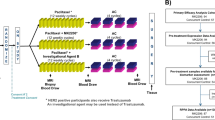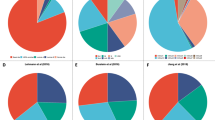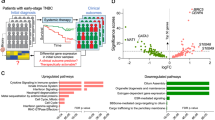Abstract
Current therapeutic outcomes for breast cancer underscore the complexity of treating a heterogeneous disease. Indeed, studies have shown that differences in gene expression among patients with the same subtype of breast cancer are correlated with the response to treatment. This strongly suggests that there is an urgent need to treat breast cancer with a personalized approach. Here we employed cell signaling pathway signatures to predict pathway activity in subtypes of MMTV-Myc mammary tumors. We then split tumors into subsets and developed individualized combinatorial treatments for two subtypes with distinct pathway activation patterns. Elevation of the EGFR, RAS and TGFβ pathways was observed in one subtype whereas these pathways were not predicted to be active in the other subtype that had high predicted activity of the Myc, Stat3 and Akt pathways. In a proof-of-principle experiment, treatment of these two subtypes with targeted therapies inhibited tumor growth only in the subtype of tumor where the therapy was designed to be active. We then analyzed gene expression profiles of human breast cancer patients and patient-derived xenograft (PDX) samples to predict pathway activity, and validated our approach of developing individualized treatments in mice with PDX tumors. Importantly, our combinatorial therapy resulted in tumor regression, including regression in PDX samples from triple-negative breast cancer. Together our data is a proof-of-principle experiment that demonstrates that cell signaling pathway signature-guided treatment for breast cancer is viable.
This is a preview of subscription content, access via your institution
Access options
Subscribe to this journal
Receive 50 print issues and online access
$259.00 per year
only $5.18 per issue
Buy this article
- Purchase on Springer Link
- Instant access to full article PDF
Prices may be subject to local taxes which are calculated during checkout





Similar content being viewed by others
References
Dent R, Trudeau M, Pritchard KI, Hanna WM, Kahn HK, Sawka CA et al. Triple-negative breast cancer: clinical features and patterns of recurrence. Clin Cancer Res 2007; 13 (Pt 1): 4429–4434.
Liedtke C, Mazouni C, Hess KR, Andre F, Tordai A, Mejia JA et al. Response to neoadjuvant therapy and long-term survival in patients with triple-negative breast cancer. J Clin Oncol 2008; 26: 1275–1281.
Perou CM, Jeffrey SS, van de Rijn M, Rees CA, Eisen MB, Ross DT et al. Distinctive gene expression patterns in human mammary epithelial cells and breast cancers. Proc Natl Acad Sci USA 1999; 96: 9212–9217.
Perou CM, Sorlie T, Eisen MB, van de Rijn M, Jeffrey SS, Rees CA et al. Molecular portraits of human breast tumours. Nature 2000; 406: 747–752.
Sorlie T, Wang Y, Xiao C, Johnsen H, Naume B, Samaha RR et al. Distinct molecular mechanisms underlying clinically relevant subtypes of breast cancer: gene expression analyses across three different platforms. BMC Genomics 2006; 7: 127.
Eo HS, Heo JY, Choi Y, Hwang Y, Choi HS . A pathway-based classification of breast cancer integrating data on differentially expressed genes, copy number variations and microRNA target genes. Mol Cells 2012; 34: 393–398.
Bild AH, Yao G, Chang JT, Wang Q, Potti A, Chasse D et al. Oncogenic pathway signatures in human cancers as a guide to targeted therapies. Nature 2006; 439: 353–357.
West M, Blanchette C, Dressman H, Huang E, Ishida S, Spang R et al. Predicting the clinical status of human breast cancer by using gene expression profiles. Proc Natl Acad Sci USA 2001; 98: 11462–11467.
Gatza ML, Lucas JE, Barry WT, Kim JW, Wang Q, Crawford MD et al. A pathway-based classification of human breast cancer. Proc Natl Acad Sci USA 2010; 107: 6994–6999.
Andrechek ER . HER2/Neu tumorigenesis and metastasis is regulated by E2F activator transcription factors. Oncogene 2015; 34: 217–225.
Hollern DP, Honeysett J, Cardiff RD, Andrechek ER . The E2F transcription factors regulate tumor development and metastasis in a mouse model of metastatic breast cancer. Mol Cell Biol 2014; 34: 3229–3243.
Fujiwara K, Yuwanita I, Hollern DP, Andrechek ER . Prediction and genetic demonstration of a role for activator E2Fs in Myc-induced tumors. Cancer Res 2011; 71: 1924–1932.
Andrechek ER, Cardiff RD, Chang JT, Gatza ML, Acharya CR, Potti A et al. Genetic heterogeneity of Myc-induced mammary tumors reflecting diverse phenotypes including metastatic potential. Proc Natl Acad Sci USA 2009; 106: 16387–16392.
Ciriello G, Gatza ML, Beck AH, Wilkerson MD, Rhie SK, Pastore A et al. Comprehensive molecular portraits of invasive lobular breast cancer. Cell 2015; 163: 506–519.
Gatza ML, Silva GO, Parker JS, Fan C, Perou CM . An integrated genomics approach identifies drivers of proliferation in luminal-subtype human breast cancer. Nat Genet 2014; 46: 1051–1059.
Chang JT, Carvalho C, Mori S, Bild AH, Gatza ML, Wang Q et al. A genomic strategy to elucidate modules of oncogenic pathway signaling networks. Mol Cell 2009; 34: 104–114.
Lehmann BD, Bauer JA, Chen X, Sanders ME, Chakravarthy AB, Shyr Y et al. Identification of human triple-negative breast cancer subtypes and preclinical models for selection of targeted therapies. J Clin Invest 2011; 121: 2750–2767.
Gonzalez-Angulo AM, Timms KM, Liu S, Chen H, Litton JK, Potter J et al. Incidence and outcome of BRCA mutations in unselected patients with triple receptor-negative breast cancer. Clin Cancer Res 2011; 17: 1082–1089.
Farmer H, McCabe N, Lord CJ, Tutt AN, Johnson DA, Richardson TB et al. Targeting the DNA repair defect in BRCA mutant cells as a therapeutic strategy. Nature 2005; 434: 917–921.
Tutt A, Robson M, Garber JE, Domchek SM, Audeh MW, Weitzel JN et al. Oral poly(ADP-ribose) polymerase inhibitor olaparib in patients with BRCA1 or BRCA2 mutations and advanced breast cancer: a proof-of-concept trial. Lancet 2010; 376: 235–244.
O'Shaughnessy J, Osborne C, Pippen JE, Yoffe M, Patt D, Rocha C et al. Iniparib plus chemotherapy in metastatic triple-negative breast cancer. N Engl J Med 2011; 364: 205–214.
Cameron D, Brown J, Dent R, Jackisch C, Mackey J, Pivot X et al. Adjuvant bevacizumab-containing therapy in triple-negative breast cancer (BEATRICE): primary results of a randomised, phase 3 trial. Lancet Oncol 2013; 14: 933–942.
Bear HD, Tang G, Rastogi P, Geyer CE Jr, Liu Q, Robidoux A et al. Neoadjuvant plus adjuvant bevacizumab in early breast cancer (NSABP B-40 [NRG Oncology]): secondary outcomes of a phase 3, randomised controlled trial. Lancet Oncol 2015; 16: 1037–1048.
Bertucci F, Fekih M, Autret A, Petit T, Dalenc F, Levy C et al. Bevacizumab plus neoadjuvant chemotherapy in patients with HER2-negative inflammatory breast cancer (BEVERLY-1): a multicentre, single-arm, phase 2 study. Lancet Oncol 2016; 17: 600–611.
Nahta R, Yuan LX, Zhang B, Kobayashi R, Esteva FJ . Insulin-like growth factor-I receptor/human epidermal growth factor receptor 2 heterodimerization contributes to trastuzumab resistance of breast cancer cells. Cancer Res 2005; 65: 11118–11128.
Xia W, Husain I, Liu L, Bacus S, Saini S, Spohn J et al. Lapatinib antitumor activity is not dependent upon phosphatase and tensin homologue deleted on chromosome 10 in ErbB2-overexpressing breast cancers. Cancer Res 2007; 67: 1170–1175.
Berns K, Horlings HM, Hennessy BT, Madiredjo M, Hijmans EM, Beelen K et al. A functional genetic approach identifies the PI3K pathway as a major determinant of trastuzumab resistance in breast cancer. Cancer Cell 2007; 12: 395–402.
Shattuck DL, Miller JK, Carraway KL III, Sweeney C . Met receptor contributes to trastuzumab resistance of Her2-overexpressing breast cancer cells. Cancer Res 2008; 68: 1471–1477.
Iwamaru A, Szymanski S, Iwado E, Aoki H, Yokoyama T, Fokt I et al. A novel inhibitor of the STAT3 pathway induces apoptosis in malignant glioma cells both in vitro and in vivo. Oncogene 2007; 26: 2435–2444.
Bhatt AP, Bhende PM, Sin SH, Roy D, Dittmer DP, Damania B . Dual inhibition of PI3K and mTOR inhibits autocrine and paracrine proliferative loops in PI3K/Akt/mTOR-addicted lymphomas. Blood 2010; 115: 4455–4463.
Yang D, Liu H, Goga A, Kim S, Yuneva M, Bishop JM . Therapeutic potential of a synthetic lethal interaction between the MYC proto-oncogene and inhibition of aurora-B kinase. Proc Natl Acad Sci USA 2010; 107: 13836–13841.
Li D, Ambrogio L, Shimamura T, Kubo S, Takahashi M, Chirieac LR et al. BIBW2992, an irreversible EGFR/HER2 inhibitor highly effective in preclinical lung cancer models. Oncogene 2008; 27: 4702–4711.
Yamaguchi T, Kakefuda R, Tajima N, Sowa Y, Sakai T . Antitumor activities of JTP-74057 (GSK1120212), a novel MEK1/2 inhibitor, on colorectal cancer cell lines in vitro and in vivo. Int J Oncol 2011; 39: 23–31.
DaCosta Byfield S, Major C, Laping NJ, Roberts AB . SB-505124 is a selective inhibitor of transforming growth factor-beta type I receptors ALK4, ALK5, and ALK7. Mol Pharmacol 2004; 65: 744–752.
Tang Y, Wu X, Lei W, Pang L, Wan C, Shi Z et al. TGF-beta1-induced migration of bone mesenchymal stem cells couples bone resorption with formation. Nat Med 2009; 15: 757–765.
Nagata Y, Lan KH, Zhou X, Tan M, Esteva FJ, Sahin AA et al. PTEN activation contributes to tumor inhibition by trastuzumab, and loss of PTEN predicts trastuzumab resistance in patients. Cancer Cell 2004; 6: 117–127.
Narayan M, Wilken JA, Harris LN, Baron AT, Kimbler KD, Maihle NJ . Trastuzumab-induced HER reprogramming in 'resistant' breast carcinoma cells. Cancer Res 2009; 69: 2191–2194.
Junttila TT, Akita RW, Parsons K, Fields C, Lewis Phillips GD, Friedman LS et al. Ligand-independent HER2/HER3/PI3K complex is disrupted by trastuzumab and is effectively inhibited by the PI3K inhibitor GDC-0941. Cancer Cell 2009; 15: 429–440.
Morrow PK, Wulf GM, Ensor J, Booser DJ, Moore JA, Flores PR et al. Phase I/II study of trastuzumab in combination with everolimus (RAD001) in patients with HER2-overexpressing metastatic breast cancer who progressed on trastuzumab-based therapy. J Clin Oncol 2011; 29: 3126–3132.
Finn RS, Crown JP, Lang I, Boer K, Bondarenko IM, Kulyk SO et al. The cyclin-dependent kinase 4/6 inhibitor palbociclib in combination with letrozole versus letrozole alone as first-line treatment of oestrogen receptor-positive, HER2-negative, advanced breast cancer (PALOMA-1/TRIO-18): a randomised phase 2 study. Lancet Oncol 2015; 16: 25–35.
Barbie TU, Alexe G, Aref AR, Li S, Zhu Z, Zhang X et al. Targeting an IKBKE cytokine network impairs triple-negative breast cancer growth. J Clin Invest 2014; 124: 5411–5423.
Hollern DP, Andrechek E . A genomic analysis of mouse models of breast cancer reveals molecular features of mouse models and relationships to human breast cancer. Breast Cancer Res 2014; 16: R59.
Hoefflin R, Lahrmann B, Warsow G, Hubschmann D, Spath C, Walter B et al. Spatial niche formation but not malignant progression is a driving force for intratumoural heterogeneity. Nat Commun 2016; 7:11845.
Yates LR, Gerstung M, Knappskog S, Desmedt C, Gundem G, Van Loo P et al. Subclonal diversification of primary breast cancer revealed by multiregion sequencing. Nat Med 2015; 21: 751–759.
Emery CM, Vijayendran KG, Zipser MC, Sawyer AM, Niu L, Kim JJ et al. MEK1 mutations confer resistance to MEK and B-RAF inhibition. Proc Natl Acad Sci USA 2009; 106: 20411–20416.
Carracedo A, Ma L, Teruya-Feldstein J, Rojo F, Salmena L, Alimonti A et al. Inhibition of mTORC1 leads to MAPK pathway activation through a PI3K-dependent feedback loop in human cancer. J Clin Invest 2008; 118: 3065–3074.
Zimmermann S, Moelling K . Phosphorylation and regulation of Raf by Akt (protein kinase B). Science 1999; 286: 1741–1744.
Turke AB, Song Y, Costa C, Cook R, Arteaga CL, Asara JM et al. MEK inhibition leads to PI3K/AKT activation by relieving a negative feedback on ERBB receptors. Cancer Res 2012; 72: 3228–3237.
Bean J, Brennan C, Shih JY, Riely G, Viale A, Wang L et al. MET amplification occurs with or without T790M mutations in EGFR mutant lung tumors with acquired resistance to gefitinib or erlotinib. Proc Natl Acad Sci USA 2007; 104: 20932–20937.
Riely GJ, Pao W, Pham D, Li AR, Rizvi N, Venkatraman ES et al. Clinical course of patients with non-small cell lung cancer and epidermal growth factor receptor exon 19 and exon 21 mutations treated with gefitinib or erlotinib. Clin Cancer Res 2006; 12 (Pt 1): 839–844.
Hollern DP, Yuwanita I, Andrechek ER . A mouse model with T58A mutations in Myc reduces the dependence on KRas mutations and has similarities to claudin-low human breast cancer. Oncogene 2012; 32: 1296–1304.
Tusher VG, Tibshirani R, Chu G . Significance analysis of microarrays applied to the ionizing radiation response. Proc Natl Acad Sci USA 2001; 98: 5116–5121.
Carvalho CM, Chang J, Lucas JE, Nevins JR, Wang Q, West M . High-dimensional sparse factor modeling: applications in gene expression genomics. J Am Stat Assoc 2008; 103: 1438–1456.
Eisen MB, Spellman PT, Brown PO, Botstein D . Cluster analysis and display of genome-wide expression patterns. Proc Natl Acad Sci USA 1998; 95: 14863–14868.
Alok JS, Moelling K . Java Treeview—extensible visualization of microarray data. Bioinformatics 2004; 20: 3246–3248.
Zhang X, Claerhout S, Prat A, Dobrolecki LE, Petrovic I, Lai Q et al. A renewable tissue resource of phenotypically stable, biologically and ethnically diverse, patient-derived human breast cancer xenograft models. Cancer Res 2013; 73: 4885–4897.
Acknowledgements
We thank the members of the Andrechek laboratory for helpful discussions. Funding for this project was provided by grants from Susan Komen Career Catalyst (KG110510) and NIH R011CA160514 to ERA.
Author information
Authors and Affiliations
Corresponding author
Ethics declarations
Competing interests
The authors declare no conflict of interest.
Additional information
Supplementary Information accompanies this paper on the Oncogene website
Rights and permissions
About this article
Cite this article
Jhan, JR., Andrechek, E. Effective personalized therapy for breast cancer based on predictions of cell signaling pathway activation from gene expression analysis. Oncogene 36, 3553–3561 (2017). https://doi.org/10.1038/onc.2016.503
Received:
Revised:
Accepted:
Published:
Issue Date:
DOI: https://doi.org/10.1038/onc.2016.503
This article is cited by
-
How to Choose a Mouse Model of Breast Cancer, a Genomic Perspective
Journal of Mammary Gland Biology and Neoplasia (2019)
-
Hydroxytyrosol inhibits cancer stem cells and the metastatic capacity of triple-negative breast cancer cell lines by the simultaneous targeting of epithelial-to-mesenchymal transition, Wnt/β-catenin and TGFβ signaling pathways
European Journal of Nutrition (2019)
-
Using gene expression data to direct breast cancer therapy: evidence from a preclinical trial
Journal of Molecular Medicine (2018)



